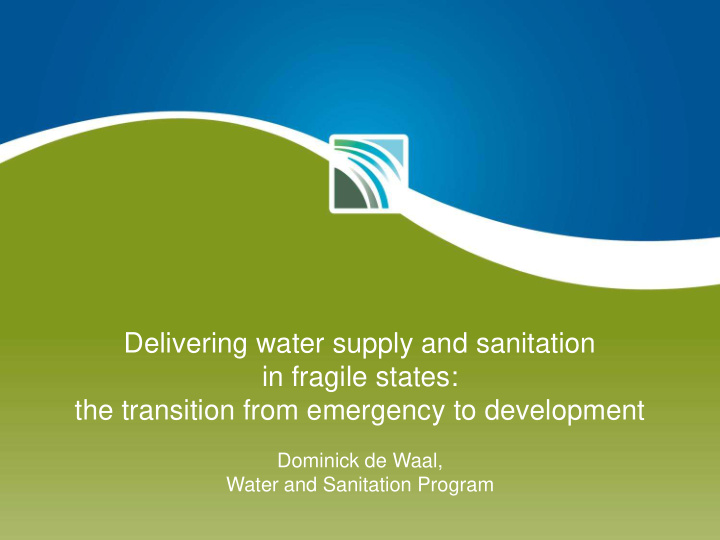



Delivering water supply and sanitation in fragile states: the transition from emergency to development Dominick de Waal, Water and Sanitation Program
Overview of presentation • Regional trends in water supply? • What can post conflict/crisis states adopt from successful ? • What is different about working in post conflict/crisis states ?
Fragile states have made least progress …
… While some low income stable countries lead the way Extending the reach and rate of WSS service delivery through combining: Effective sector reform with Linking the WSS sector to core country systems National planning Budget and expenditure management Procurement management Human resource management and civil service reform Decentralized service delivery capacity
Low income stable countries have the strongest service delivery pathways Enabling Developing Sustaining services services services 3.0 Strong 2.5 2.0 Country Status 1.5 Overview Scorecard 1.0 0.5 Weak 0.0 Resource Rich LIC-NonFragile LIC-Fragile Stable R
Initiate a community of practice with 3 aims 1. Enhance WSS sector actors understanding of 'core' country systems 2. Enhance core country systems actors understanding of the needs of the WSS sector 3. Chart a transition pathway from emergency to development for the sector in each country
Five ‘constituencies’ involved in initial conference Country WSS Country public actors finance actors ESA public ESA WSS finance specialists specialists Countries that have successfully transitioned
CAR, DRC, Haiti, Liberia, Sierra Leone, Sudan, Zimbabwe Ministries of Ministries of Country WSS Country public water and health finance and local actors finance actors government ADA, AfDB, World Bank, ESA public ECHO, Norad, ESA WSS UNDP, finance UNDP, UNICEF, specialists USAID specialists USAID, WaterAid, WSP, World Bank Countries that have Ethiopia, Rwanda, successfully Uganda, transitioned
Opportunities to accelerate sector transition 1. Build on the strengths of fragile states 2. Provide sector leadership with examples of transition trajectories 3. Initiate dialogue between line ministries responsible for WSS and ministries managing core country systems 4. Use aid modalities to promote linkages between the WSS sector and country systems
1. Build on the strengths of Political fragile states will Low WSS Public line-ministry financial capacity management Decentralized government Local private Civil sector society 10
– 2. Provide sector leadership with examples of transition trajectories Donor harmonization Country-led WB project builds capacity of program Ethiopia regions for RWSS Decentralization of HR capacity to regional water bureaus Increasing budget allocations to RWS from block grants WB project preparation Roll out of IBEX Shift to multilateral programs Interventions since 2000 Block grants to regions Sector policy update National PRS, decentralization to regions and PFM reform Bilateral RWSS projects in the Ethiopia Social Rehabilitation and 90s Development Fund (ESRDF) 1996-2004 Emergency RWS coverage increased: Ethiopia responses Gov : 15 % in 1994 to 53.9 % in 2008 JMP : 8% in 1990 to 26% in 2008 Timeline 1995 2000 2005 2015 2010
3. Initiate dialogue between WSS and core country systems ministries early Many of the problems of WSS sector development are symptoms of the lack of dialogue between the WSS sector and the Ministry of Finance – resolving these requires sustained dialogue between these two sets of actors. John Davis, Accountant General for Liberia The capacity conundrum Can influence policy and institutional formation while it is still in flux. Investment in core country systems is more than enabling countries to better manage fiduciary risk. Equally important is re-linking financial management with the political and policy processes and service delivery systems
4. Use aid modalities to promote linkages between WSS sector and country systems Choice and use of aid modalities is critical because international engagement is often extensive post-crisis Nature of aid modalities during early recovery has a major impact on later modalities and the development of country systems. ‘Developing capacity by using it’ calls for taking initial risk and working in partnership with countries to: • link incremental improvements in country implementation capacity • incremental increases in the amounts of funds being channelled through country systems.
Country Priorities for facilitating the transition -led program from emergency to development Development Reconstruction Recovery Emergency
Country Sierra Leone - development -led Extent and functionality of program sector coverage limited. Need to map infrastructure to update sector status. Strong PFM systems but limited donor WSS funding channeled through them Request DPs to stream Development funding through though government systems Reconstruction Recovery Emergency
What is different about WSS development in fragile states? Same goals different ways of getting there … Locus of authority – Need to reestablish the locus of public authority Volatility - Be opportunistic about putting sector building blocks in place Human capacity – Absolute deficits of trained personnel: engineers, PFM, procurement, contract management, community mobilization Build in resilience - Shocks, internal or external, can easily pull country systems and the WSS sector back down the transition trajectory
www.wsp.org
Recommend
More recommend